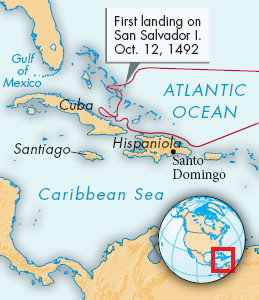Understanding Western Society
Printed Page 421
The Problem of Christopher Columbus
Christopher Columbus is a controversial figure in history — glorified by some as a courageous explorer, vilified by others as a cruel exploiter of Native Americans. Rather than judging Columbus by debates and standards of our time, it is more important to understand him in the context of his own time. First, what kind of man was Columbus, and what forces or influences shaped him? Second, in sailing westward from Europe, what were his goals? Third, did he achieve his goals, and what did he make of his discoveries?
In his dream of a westward passage to the Indies, Columbus embodied a long-
What was the object of this first voyage? Columbus gave the answer in the very title of the expedition, “The Enterprise of the Indies.” He wanted to find a direct ocean trading route to Asia. Rejected for funding by the Portuguese in 1483 and by Ferdinand and Isabella in 1486, the project finally won the backing of the Spanish monarchy in 1492. Inspired by the stories of Mandeville and Marco Polo, Columbus dreamed of reaching the court of the Mongol emperor, the Great Khan (not realizing that the Ming Dynasty had overthrown the Mongols in 1368). Based on Ptolemy’s Geography and other texts, he expected to pass the islands of Japan and then land on the east coast of China.
How did Columbus interpret what he had found, and in his mind did he achieve what he had set out to do? Columbus’s small fleet left Spain on August 3, 1492. He landed in the Bahamas, which he christened San Salvador, on October 12, 1492. Columbus believed he had found some small islands off the east coast of Japan. On encountering natives of the islands, he gave them some beads and “many other trifles of small value,” pronouncing them delighted with these gifts and eager to trade. Believing he was in the Indies, he called them “Indians,” a name later applied to all inhabitants of the Americas.
Scholars have identified the inhabitants of the islands as the Taino people, speakers of the Arawak language, who inhabited Hispaniola (modern-
The landing party found only small villages. Confronted with this disappointment, Columbus apparently gave up on his aim to meet the Great Khan. Instead, he focused on trying to find gold or other valuables among the peoples he had discovered. The sight of Taino people wearing gold ornaments on Hispaniola seemed to prove that gold was available in the region. In January, confident that its source would soon be found, he headed back to Spain to report on his discovery. News of his voyage spread rapidly across Europe.3

Over the next decades, the Spanish would follow a policy of conquest and colonization in the New World rather than one of exchange with equals. On his second voyage, Columbus forcibly subjugated the island of Hispaniola and enslaved its indigenous peoples. On this and subsequent voyages, Columbus brought with him settlers for the new Spanish territories, along with agricultural seed and livestock. Columbus himself, however, had limited skills in governing. Revolt soon broke out against him and his brother on Hispaniola. A royal expedition sent to investigate returned the brothers to Spain in chains. Columbus was cleared of wrongdoing, but the territories remained under royal control.
Columbus was very much a man of his times. To the end of his life in 1506, he believed that he had found small islands off the coast of Asia. He could not know that the scale of his discoveries would revolutionize world power, raising issues of trade, settlement, government bureaucracy, and the rights of native and African peoples.